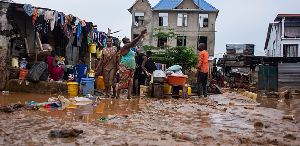I was lost in thought, and I didn’t hear him at first. I was thinking of greed and cruelty, of men and women captured and imprisoned and shipped off and sold. I was sitting on the wall of a slaving fort in Ghana, West Africa, and for a moment it had all just got too much.
“Excuse me, is something troubling you?” asked the young man again. He spoke softly, as if gently awakening a snoozing relative. I shook myself for a moment, and collected my thoughts, but there didn’t seem much to say.
“Yes,” I replied. “This.” And I looked around at the absurdly romantic white walls of Elmina, a castle that sent hundreds of thousands of Africans into slavery and death.
“Ah, I see,” he smiled. “But that was all a long time ago. Now you are in a different Ghana, a different Africa. Come and join me and my friends and we will all drink to the future.”
They’re like that in Ghana. There can’t be many places that have such a bitter history, but such a benevolent present: the country may be poor, but it’s free, stable, democratic and charmingly, compulsively, almost overwhelmingly, friendly. They’re a people who live in the here and now, and they’d sooner not dwell on the past. Which is fair enough — but, ironically, that’s what I’d come here to do.
It was a rich country once, referred to as the Gold Coast by Europeans, who scrambled to build coastal forts in order to cement treaties and foster trade in gold, ivory, mahogany and pepper. But the free market spotted wider margins in slaving and, from the mid-1600s until abolition, an estimated 7m people were “exported” to the New World. All the usual suspects — Portuguese, Dutch, French and British — left their fingerprints in the form of the stunning slave forts that punctuate the coastline, on average one every 10 miles. Dominating horizons with sand-castle simplicity, their inanimate bulk contrasts starkly with the vibrant village life that crowds all around.
Slowly but surely, the authorities are starting to realise that they might have a tourist attraction on their hands, and the castles are being restored, and even marketed in a haphazard fashion. Their combination of brooding beauty and sinister purpose is unique: hardly the most conventional visitor attraction, but a draw nonetheless.
Elmina is a classic of the genre. I approached it from the beach, a broad palm-fringed crescent of sand with single-sail pirogues pitching in the swells. Villagers passed en route to market, head baskets tightly packed, diminishing gracefully in the heat haze. Kids were warming up for a school sports day. Ordinary life meandered on, and all under the imperious gaze of a castle rising up from the coastal crags: bare white walls as tall as palm trees, red-roofed buildings within standing higher still. It’s a pirate vision: you expect to see Errol Flynn leaping across the ramparts, buckling and swashing as he goes.
The reality was somewhat different. This is the oldest castle in Ghana, built by the Portuguese in 1482. Once inside, I was introduced to Ato, the guide. His speech was slow and measured, like a doctor or driving instructor, as he told of the women kept naked and chained, sleeping on the bare rock floor without sanitation. We stood in one of the dungeons, a ghastly dank space where 150 souls, aged from 12 to 30, were kept shackled for up to three months. Two-thirds of them died before they could even be shipped out: some say this was a deliberate policy to eliminate the weak before the long (and costly) sea voyage.
Our tour ended at the breezy balcony of the governor’s residence. It was about the same size as the dungeon.
I wondered how Ato coped, telling and retelling this history of horrors. He told me that he’d been at the castle for several months, doing his national service, yet he still found that speaking at a steady speed was the only way to manage. “I stick to the script. Otherwise, I start to think, and then I break down.”
SO I did go for that drink. I needed cheering up, and Orlando, the young man who had showed such concern as I sat on the battlements, turned out to be just the guy for the job. He was celebrating his 28th birthday, and the guest list at his party included everyone he knew — which, as of now, included me. That night, the dusty courtyard of his single-storey house was packed with revellers. An enraptured DJ sat hemmed in by a pyramid of thunderous speakers, and there was booze, plantain nibbles and a fantastic atmosphere. Believe me; nobody loiters in the kitchen at a Ghanaian party.
So it was with a slightly thick head that I set out the next day for Cape Coast Castle, built by the Swedes in 1653 and snatched by the British 12 years later. This is Ghana’s flagship fortification, and has an excellent museum. From the whitewashed walls and rows of black cannons, the castle commands beautiful panoramas of the rocks and surf.
But again, you only have to descend a worn flight of steps to find the hideous gloom of the dungeons. The first chapel-sized room had once incarcerated 300 “rebellious” slaves, restraining those males who had resisted. The air was hot and fusty. There was a single ventilation hole and a food hatch, both high up in the time-tarnished wall, and traces of pegs where chains once bolted people to the floor.
From the dungeons, the slaves were forced to shuffle down a long passageway through the “door of no return”, then loaded into ships and wrenched from their homeland for ever.
Outside, as at Elmina, modern life carried on, unconcerned with the past. A football game was in progress: aside from the dark-red dust of the pitch, the draining humidity and the odd stray goat, it was much like a schoolboy game anywhere — and as almost everyone in Ghana speaks English, there were even cries of “Man on!”, “Square!” and “On the head!” to make me feel at home. The half-time barracking would have made Brian Clough blush.
It was all rather odd, and it was about to get odder. Heading back to the capital, Accra, on a tro-tro (the local minibus), we passed a mass of brightly painted capsules lined up outside a two-storey wooden shack. Intrigued, I jumped off.
They were coffins — finely crafted, full-colour coffins, all dressed up to look like a significant object from the deceased’s life. From right to left, we had a cow, a pineapple, a bottle of beer, a fish, another bottle of beer, a mango, a crayfish and a KLM airliner. Local custom puts great store in the aptness of one’s casket — Sowah, the carpenter, was working on a Mercedes for a rich man, and a ballpoint pen for a student.
And the jet? Sowah beamed: “A KLM pilot, of course.” I asked him what he’d like for himself. “A plane,” he said proudly, “the carpenter’s kind.” And he mimed taking shavings.
MY THIRD castle was Fort Metal Cross, and my first sight of it was obscured by a Sussex farmer on a JCB. “Mr Rob”, as Robert Fidler is known to the locals, is one of life’s doers. I met him in the village of Dixcove. We were two surprised white faces in a sea of smiling black ones, and we were both determined to be unfazed by the situation. We did the “Dr Livingstone, I presume” routine so beloved of Europeans in Africa — a tricky act to bring off when one of you is sitting on a huge yellow digger — and he invited me to his castle.
With the blessing of local chiefs and permission from the Board of Museums, Fidler has secured a 25-year lease on Fort Metal Cross. He has big, but sympathetic, plans for the place: the external fabric of the fort, built by the British in 1692, cannot be changed — it’s a Unesco World Heritage Site — but inside he envisages a restaurant and a hotel, and outside, aid for the school and even films projected onto the castle wall for local kids.
“Well, they said farmers should diversify,” he joked that evening, as we sat on the battlements and ate freshly caught tuna with a spicy palm-nut sauce. The smell of fried plantain and the sound of distant laughter wafted on the breeze. Strange really: two Brits sitting on a cannon and chatting into the night, much as the night watch centuries before.
Rob had said I could spread my sleeping bag on the floor of the castle if I liked (those hotel plans have a long way to go), and after the last beer had been downed, I descended the steps to a big bare room below the ramparts. The crashing of the surf changed from a distinct repetition of sound into a muffled constant, like the noise when putting your ear to a large seashell: the same sound heard by the penned-in prisoners.
I am not a believer in ghosts, but I am a believer in the spirit of place, the imprint of men and women on their surroundings. I didn’t know how many people had died within these walls, or been sent from here to a lifetime of sadness. Quantities somehow ceased to matter: whether one person or 100,000 had passed through, these walls had still seen appalling suffering. My imagination would not rest, and sleep would not come. I waited for the shadows to dissolve with the dawn, and the door through the 1?-metre-thick walls to become discernible once more. And then — unlike so many who had spent uncertain nights here — I strolled outside into the sunshine, and went on my way.
Richard Green travelled as a guest of British Airways and Ghana Travel














